How to Indian Meal Prep: A Guide to Planning, Prepping, and Saving Time
If you’ve ever found yourself scrambling to cook every single meal from scratch during the week, meal prep might be your game-changer. This time, we’re focusing solely on Indian meal prep, and it’s not about eating the same curry/masala/dish all week.
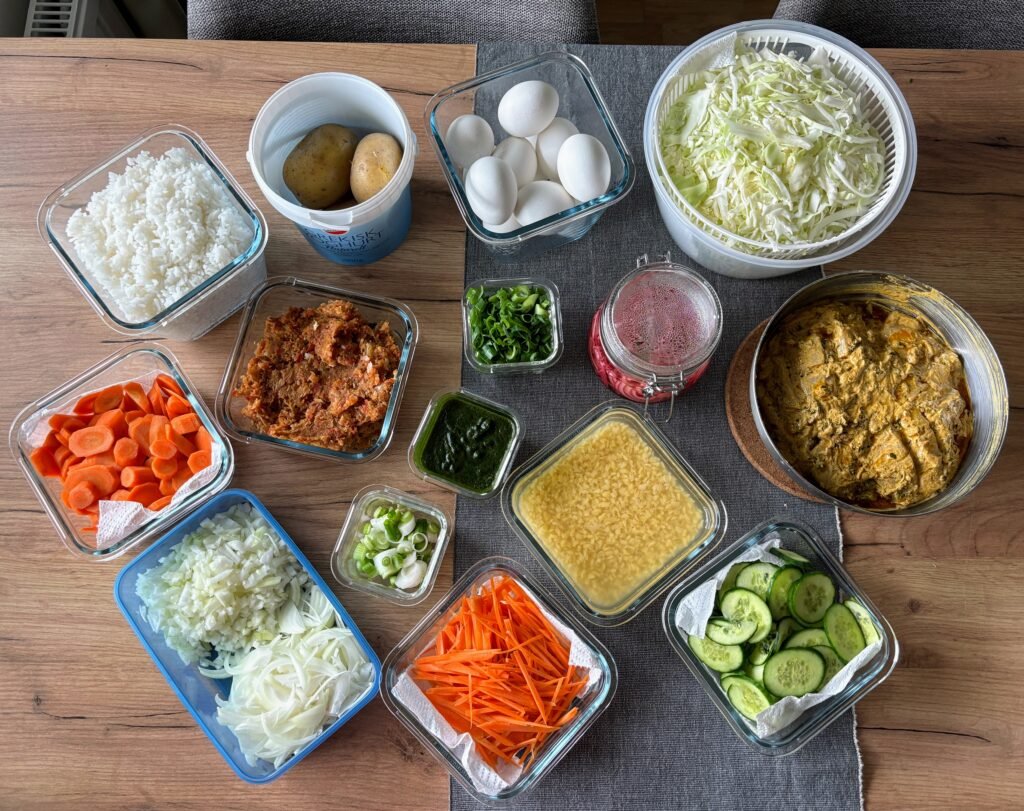
It’s about smart prepping of versatile elements so you can mix and match flavors and textures across multiple Indian dishes. That way, your food stays interesting, nourishing, and easy to put together, even on your busiest days.
In this blog post, I’m breaking down my 3-part Indian meal prep series (find them on my Instagram!) into actionable steps: how to plan your menu, batch prep efficiently, and use prepped ingredients to make fresh, diverse Indian meals, all while saving serious time.
Why Indian Meal Prep Works
Indian meals can be complex – they often include dal, sabzi, chutneys, curries, roti, rice, stir-fries, and more. That’s a lot to cook from scratch daily. But prepping your base ingredients, condiments, and staples in advance simplifies the process without sacrificing variety.
Meal prepping helps with:
✅ Time-saving: Most dishes come together in just 10–15 minutes
✅ Mental ease: You know what you’re making
✅ Waste reduction: You only prep what you need
✅ Cost-efficiency: Less ordering out
Step 1: Plan a Smart Indian Menu (Not Just a Batch Cook)
I only plan for weekday lunches and dinners (Mon–Fri), keeping Friday dinner flexible for leftovers or eating out. That makes the prep achievable and adaptable.
Start with the proteins
Pick 2–3 proteins for the week. This week I chose:
- Eggs
- Chicken
- Paneer
But you can also choose from other great Indian-friendly options:
- Tofu
- Soya chunks
- Moong dal (not a complete source of protein)
- Chana (chickpeas) (not a complete source of protein)
- Rajma (kidney beans) (not a complete source of protein)
- Fish
Then pick your carbs
Rotate through familiar and diverse options:
- Rice (white, brown, or jeera rice)
- Roti / paratha / thepla
- Potatoes (boiled or roasted)
- Noodles (for Indo-Chinese)
- Pasta
- Bulgur
- Quinoa
This week I chose: Rice, Roti, Bread, Pita, Noodles
Add veggies
Choose versatile vegetables that can be used in multiple dishes:
- Onions, tomatoes, garlic, ginger (base)
- Cabbage, carrots, capsicum, spring onions (for sabzis and noodles)
- Lettuce or cucumber (for wraps/salads)
- Spinach or methi (for paratha or stir-fries)
This week was:
- White Onion
- Red onion
- Tomato
- Green chilli
- Garlic & Ginger
- Cabbage
- Potato (used as a veggie, not a carb here)
- Cucumber sliced
- Carrot
- Spring onion
Condiments = flavor magic
These elevate your Indian meals. By adding a condiment or two, it can completely change the eating experience of a relatively simple meal. This is a trick you should use to add some variety in meals if you’re sticking to the same base for two or more consecutive meals.
✅ Mint-coriander chutney (used in egg curry and wraps or on the side)
✅ Pickled onions (adds tang and crunch)
Other options:
- Garlic chutney
- Green chili pickle
- Mango or lemon pickle
- Raita
Based on this, below is the final menu
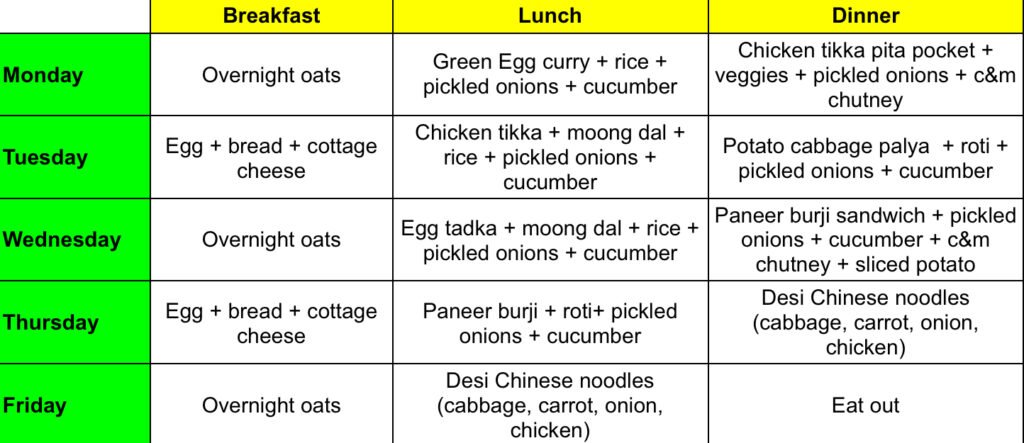
By simply changing the way somethings are eaten or presented, you immediately add variety without much effort. You can totally move things around depending on your preference. Just keep in mind the spoilage factors of dishes and elements, and place dishes with pre-cooked ingredients/prep that may spoil early, earlier in the week.
Step 2: Break It Into Elements & Prep
Once your menu is set, break prep into tasks instead of dishes – that way, you don’t repeat work or mess up the kitchen multiple times.
Prep activities by type:
- Boil: Eggs, potatoes, dal, rice
- Marinate: Chicken Tikka (refrigerate if using within 2 days; freeze if later)
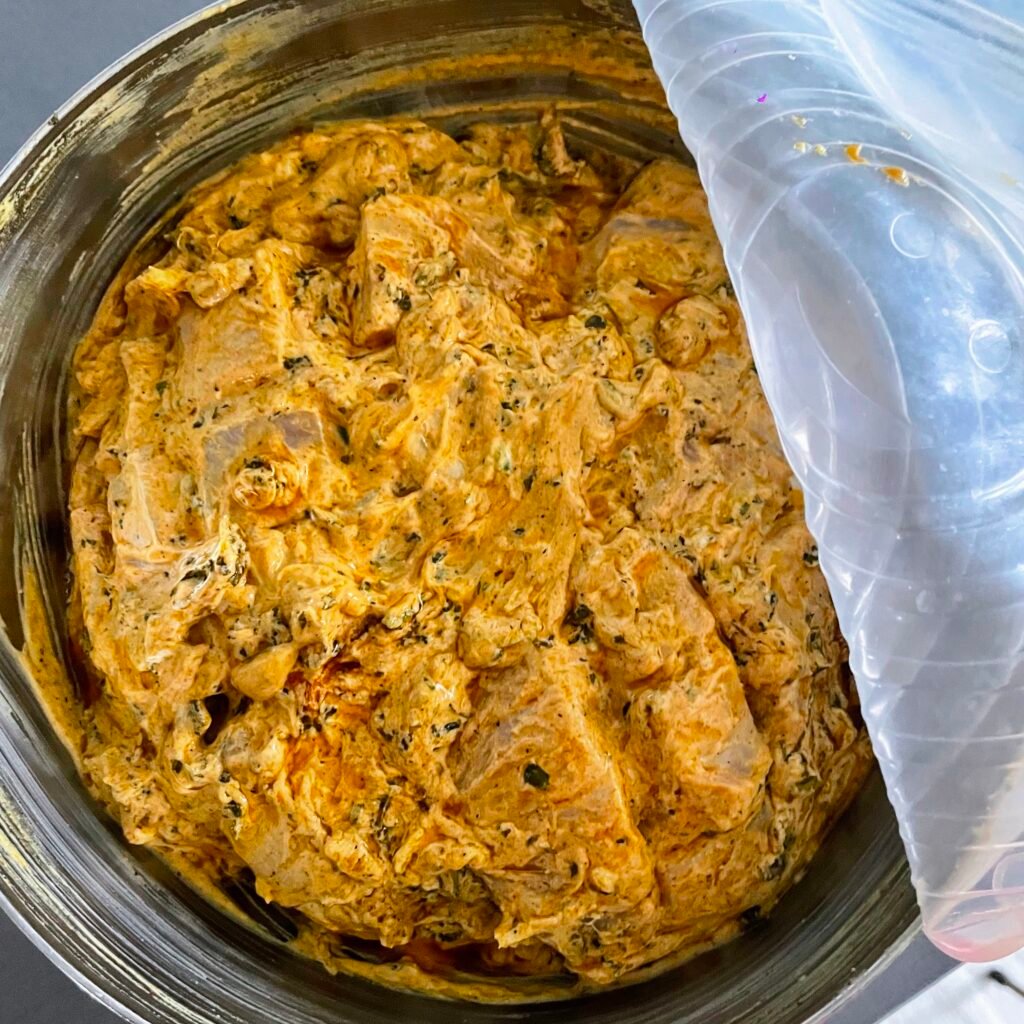
- Chop veggies:
| Ingredient | Prep Form | Used For |
|---|---|---|
| Onion (White) | Sliced, Diced, Minced | Noodles, garnish, curry base |
| Onion (Red) | Sliced | Pickled onions |
| Garlic & Ginger | Minced, Smashed | Curry base, marinade |
| Green Chilli | Chopped | General |
| Tomato | Pureed | Curry base |
| Cabbage | Shredded | Noodles, sabzi |
| Potato | Boiled | Sabzi, sandwich |
| Carrot | Julienne, Sliced | Noodles, sides |
| Spring Onion | Whites & greens separated | Garnish, noodles |
| Cucumber | Sliced | Sides |
| Chicken | Marinated | Chicken tikka |
💡 Pro Tip: Start with aromatics (onion, garlic, ginger), then let the curry base cook while you continue chopping other veggies. This saves time and keeps momentum.
Cook:
- Curry base: Onion, tomato, garlic, and ginger cooked in cumin-seeded oil. No spices yet, so it stays neutral and adaptable.
- Start with oil, cumin seeds and then onion. Once onions are softened and browned add tomato puree and let it come together well and reduce and thicken
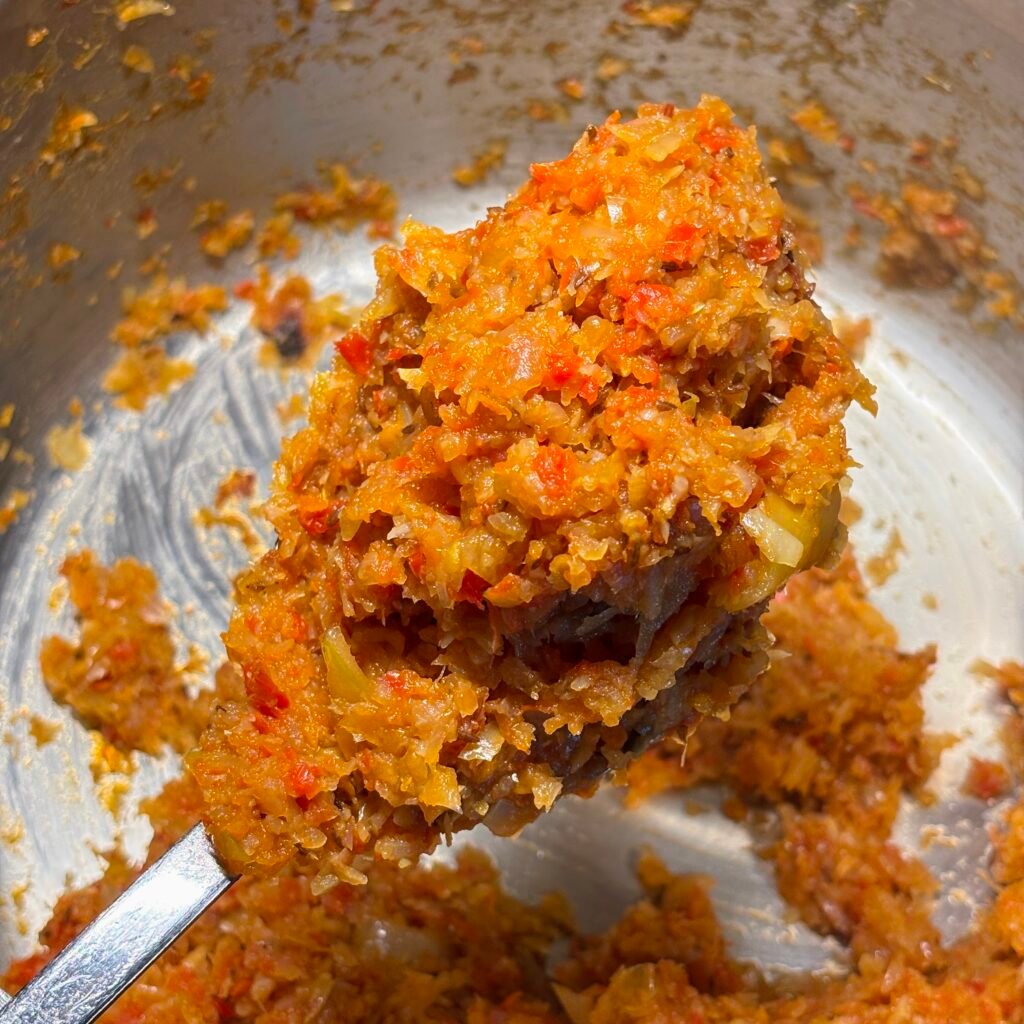
Make Condiments:
- Green chutney (Coriander, mint, garlic, ginger, green chilli, salt, pepper, lime juice)
- Pickled red onions (equal parts water and vinegar made warm (do not boil) poured over thinly sliced red onions and green chilli. store in an airtight container in the fridge)
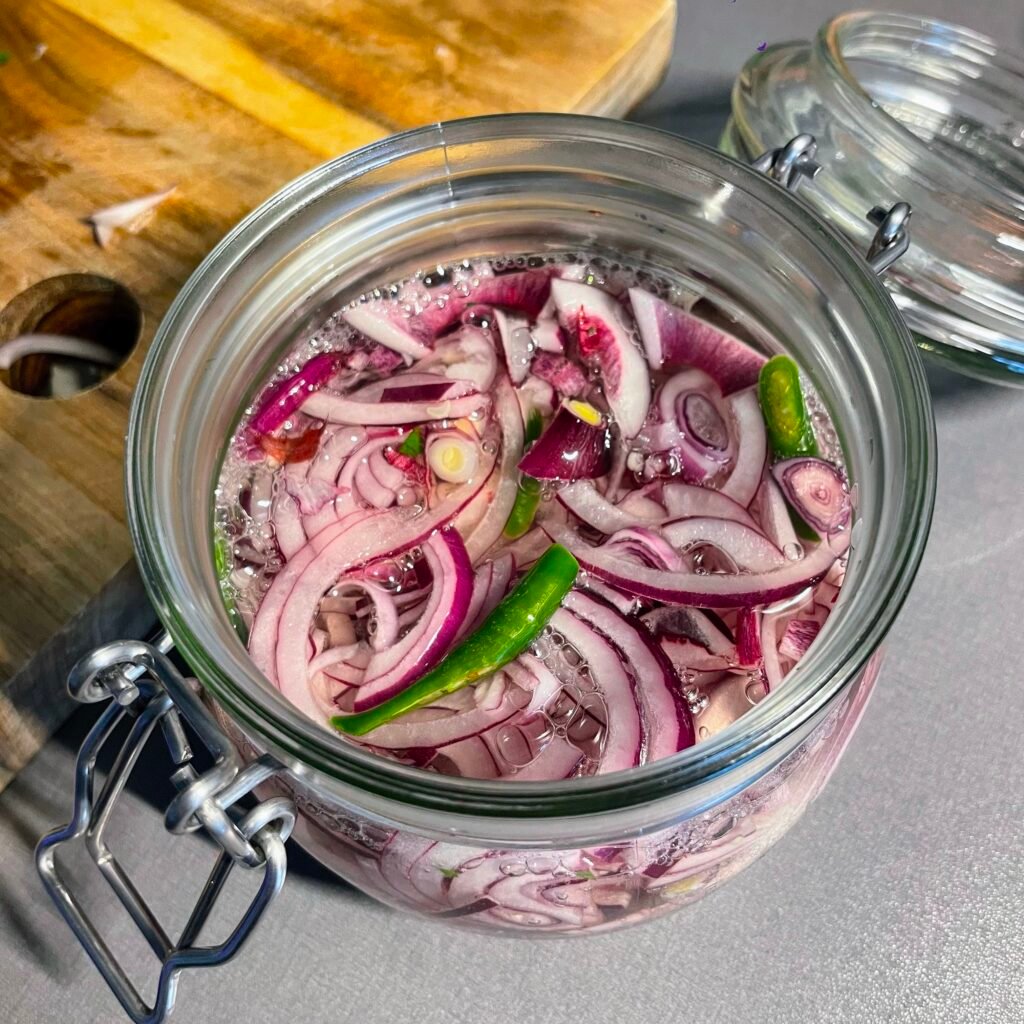
Meal Prep Storage Tips and FAQ:
👉 How long can I store boiled eggs in the fridge?
If you’re wondering whether you can store boiled eggs, peeled or unpeeled, here’s the answer:
- Unpeeled (with shell): 5-7 days in the fridge in an airtight container.
- Peeled: 4–5 days in the fridge in an airtight container with a damp paper towel to prevent drying.
Tip: Always refrigerate boiled eggs within 2 hours of cooking to prevent bacterial growth. Do a quick check frequently to check if its still safe to eat, if you find a weird or funky smell, discard it.
👉Can I store cooked eggs like scrambled eggs or omelets?
Yes, cooked eggs can be prepped in advance and stored for the week:
- Shelf life: 3 to 4 days in the fridge in an airtight container.
Reheat gently to preserve texture. This makes breakfast meal prep fast and easy.
👉 Is it safe to store chopped onions?
Yes, it’s completely safe to store chopped onions in the fridge when kept in a sealed, airtight container. They typically last for 6-7 days.
Ayurvedic view: I recently learned through someone who commented on the meal prep video that, according to Ayurveda, it’s not recommended to store cut onions. They are considered “tamasic,” meaning they lose their vital energy (prana) and are thought to absorb negative vibrations or toxins from the environment. If you’re following Ayurvedic principles, it’s best to use freshly chopped onions.
Modern view: From a scientific standpoint, storing chopped onions in the fridge is safe as long as hygienic practices are followed.
👉 What is the best way to store fresh herbs like coriander or mint?
To keep herbs fresh in the fridge, wrap them in a slightly damp paper towel and place them inside a zip-lock bag or airtight container.
- Shelf life: 1 to 2 weeks depending on the herb.
- Chopped herbs: Wrap thoroughly dried, chopped herbs in a dry paper towel and store in an airtight container in the fridge; they stay fresh for 2–3 days.
Alternative method: Store herbs like coriander or parsley upright in a glass of water (like a bouquet), then loosely cover with a plastic bag. This helps maintain freshness for a longer period.
👉 How long can I store cut cucumbers and carrots?
Here’s the best way to store cut vegetables for meal prep:
Wrap cucumbers and carrots in dry kitchen roll or paper towel and place them in an airtight container.
- Shelf life: 4 to 5 days
Bonus tip: Carrots can also be stored in a container of water in the fridge. Just change the water every couple of days.
👉 How do I store chopped or shredded cabbage?
If you want to keep meal prep vegetables fresh all week, especially cabbage:
- Line the storage container with paper towel to absorb excess moisture.
- Store shredded or chopped cabbage in this container in the fridge.
- Shelf life: 5 to 6 days
This prevents sogginess and helps the cabbage stay crisp.
👉 How do I store curry base (cooked onions and tomato) for meal prep?
Store cooked curry base in an airtight container in the fridge for up to 4–5 days. For longer storage, freeze in portions for up to 2 months. Reheat thoroughly before using in different curries.
👉 Why should I store vegetables with kitchen roll or paper towel?
This is one of the most effective, low-effort hacks for meal prepping:
- It absorbs excess moisture, which can otherwise promote mold and bacterial growth.
- It prevents sogginess, especially in watery vegetables like cucumbers and cabbage.
- It helps to maintain a balanced humidity level inside containers.
This is the reason why many meal preppers store vegetables with kitchen roll to keep them fresh longer.
👉Can I store marinated chicken or paneer?
Yes. You can safely store marinated chicken or paneer in the refrigerator:
- In the fridge: Store in an airtight container for up to 2 days.
- In the freezer: Store in portioned freezer bags for up to 2 months (texture of paneer may change)
This is an excellent strategy for meal prep with proteins.
👉 How do I store paneer after opening or cutting?
You can keep paneer fresh by:
- Storing it in a container with fresh water (change daily), or
- Wrapping it in a damp cloth and placing it in an airtight container.
- Shelf life: 3 to 5 days in the fridge
Paneer can also be frozen, although the texture may change slightly once thawed.
👉 Can I store cut tomatoes for meal prep?
Yes, but with caution. Store cut tomatoes in an airtight container, but they’ll lose texture over time.
- Store in an airtight container.
- Shelf life: 2 to 3 days
For salads or raw use, cut tomatoes fresh just before serving for best flavor and texture.
👉 How do I store blanched or steamed vegetables like broccoli or green beans?
After blanching or steaming, allow vegetables to cool completely. Then store in a container lined with kitchen roll.
- Shelf life: 3 to 4 days
Blanching helps lock in color, nutrients, and texture — ideal for meal prep vegetables.
👉 How do I store cooked rice or quinoa?
If you’re wondering how to store cooked rice or quinoa for meal prep:
- Let it cool fully before transferring to an airtight container.
- Shelf life: 4 to 5 days in the fridge
- Freezer: Up to 1 month
Tip: Spread the rice out to cool quickly and reduce risk of bacterial growth.
👉 Final Takeaway
- Always use airtight containers to prevent spoilage.
- Line containers with paper towel to control moisture and extend shelf life.
- Label and date your containers to keep track of freshness.
- Use the FIFO method (First In, First Out) when planning meals.
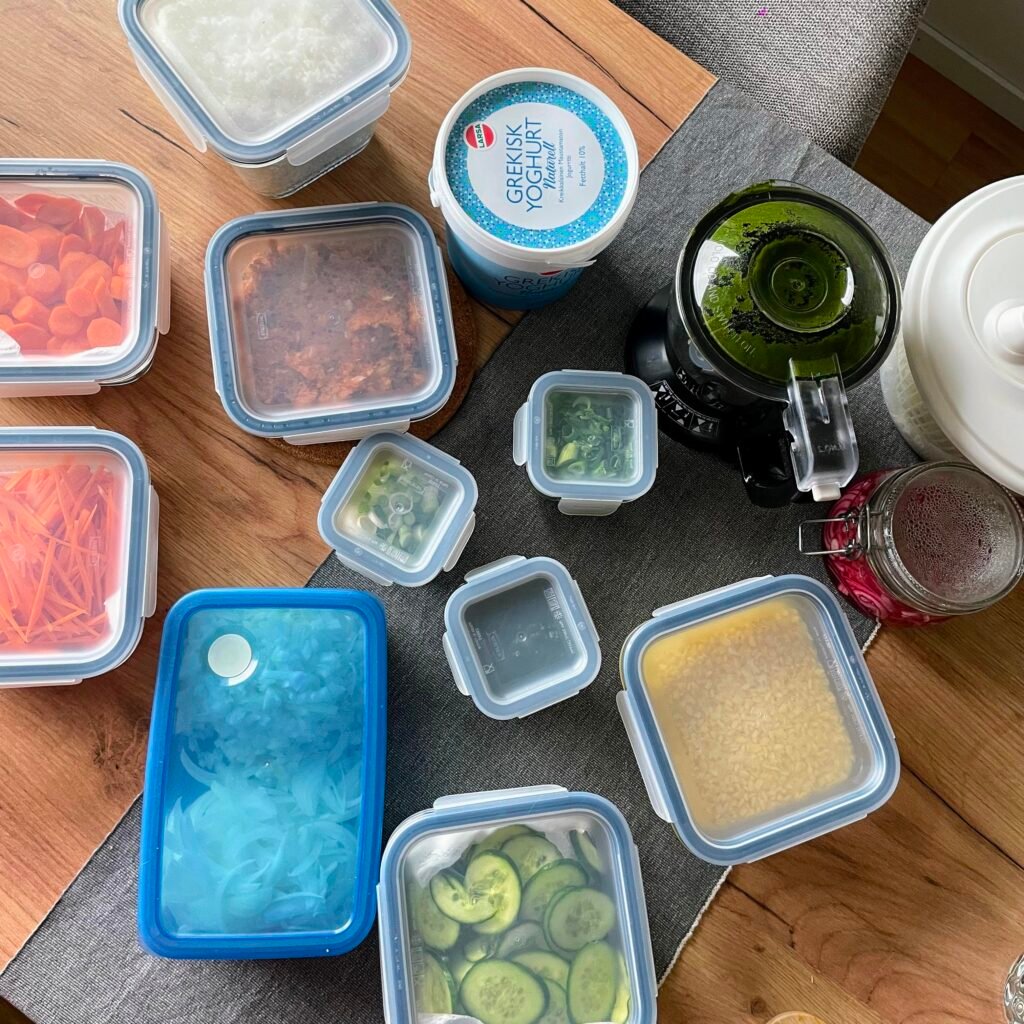
Step 3: Actual Weekly Meals – Finished Dishes
Here’s what a real Indian meal prep week looked like:
Monday
| Meal | Dish | Components / Ingredients |
|---|---|---|
| Lunch | Egg Curry + Rice + Veggies | Egg curry: – 1 tbsp mustard oil – Cinnamon stick, cloves – Green chilli – 2–3 tbsp onion tomato base – Coriander, cumin powder – 2-3 tbsp Chutney, yogurt – 6 eggs – Kasuri methi, salt, water Sides: cucumber, carrot, pickled onion |
| Dinner | Chicken Tikka Pita Pocket | – Chicken tikka (link to recipe) – Cabbage, pickled onion – Coriander Mint Yogurt: chutney + yogurt + salt – Plain coriander mint chutney – Cucumber |
Time saved: ⏱️ 20–25 mins
Tuesday
| Meal | Dish | Components / Ingredients |
|---|---|---|
| Lunch | Moong Dal + Leftover Chicken + Rice + Cucumber + Pickled Onion | Dal: – Onion tomato base – Water, salt – Red chilli, coriander, turmeric, cumin powders – Pre-cooked moong dal Tadka: Ghee, garlic, curry leaves, thing Garnish: coriander |
| Dinner | Potato-Cabbage Sabzi (Palya) + Roti + Cucumber and Carrot + Pickled Onion | Palya – Oil, mustard + cumin seeds – Hing, dry red chilli – Shredded cabbage – Boiled potato chunks – Chilli, turmeric, coriander powder – Kasuri methi |
Time saved: ⏱️ 25–30 mins
Wednesday
| Meal | Dish | Components / Ingredients |
|---|---|---|
| Lunch | Egg Tadka + Rice + Dal + Pickled Onion | Egg tadka – Oil, mustard + cumin seeds, curry leaves – Diced onion – Chilli, cumin powder – Halved boiled eggs |
| Dinner | Paneer Bhurji & Potato Sandwich | Bhurji: onion tomato base, chilli, turmeric, coriander powder, shredded paneer, water Potato slices: pan-fried with salt, chilli powder Assembly: toasted bread, chutney, bhurji, potato, diced & pickled onions, chutney, toasted bread |
🕒 Time saved: ~20–30 mins per meal
Thursday
| Meal | Dish | Components / Ingredients |
|---|---|---|
| Lunch | Paneer Bhurji + Roti + (Palya Leftover) | – Leftover paneer bhurji – Roti – Leftover palya (optional) |
| Dinner | Desi Chinese Chicken Noodles | – Chicken breast stir-fried with salt, chilli flakes – Oil, sliced onion, garlic, green chilli, spring onion white – Shredded cabbage, julienned carrots, – Seasoning: soy sauce, sweet chilli sauce, sriracha, MSG, white pepper, salt |
🕒 Time saved: ~30–35 mins per meal
Friday
| Meal | Dish | Components / Ingredients |
|---|---|---|
| Lunch | Desi Chinese Chicken Noodles (leftovers) | Same as Thursday dinner |
| Dinner | Eat Out | – |
🕒 Time saved: 45 minutes
As you can see, I moved a few things from the intended menu slightly, but it didn’t affect anything.
🧮 Time Savings: From Scratch vs With Prep
| Dish | From Scratch | With Prep |
| Egg Curry | 40 mins | 10 mins |
| Dal | 40 mins | 15 mins |
| Paneer Bhurji | 25 mins | 10 mins |
| Potato-Cabbage Sabzi | 30 mins | 10 mins |
| Chicken Tikka Pita | 45 mins + marination time | 15 mins |
| Desi Chinese Noodles | 45 mins | 15 mins |
👉 Total Time Saved: 6-7 hours/week!
Things to Avoid in Indian Meal Prep
❌ Don’t spice your onion tomato base – season during final cooking (this allows you to season based on the dish)
❌ Don’t mix chopped veggies that cook at different speeds (e.g., spring onion whites and greens)
❌ Never store wet veggies, they spoil faster
❌ Don’t leave marinated raw meat in the fridge beyond 2 days – freeze it
More Indian Meal Prep FAQs
Q: Can I freeze Indian curry base?
Yes! Make a spice-free base with onion, tomato, ginger, and garlic. Store in airtight containers or ice trays.
Q: Can I meal prep Indian vegetarian dishes?
Absolutely! Prep dals, sabzis, chutneys, and roti in advance. Great for Indian veg meal prep.
Q: Can I use the same curry base for different Indian dishes?
Yes. Add spices like garam masala, coriander powder, kasuri methi, coconut milk etc to customize it for each dish – from paneer curry to egg masala.
Q: Is Indian meal prep good for beginners?
Definitely. Start with 2 proteins and simple sabzis. Stick to staples like dal, rice, and eggs until you gain confidence.
Q: Can I move elements/dishes around during the week?
Yes, however, keep in mind spoilage factors and adjust accordingly.
Disclaimer
The information shared in this blog is based on my personal experience with meal prepping and storing produce in my home kitchen. Please use your own discretion while storing and prepping ingredients, as produce freshness, climate, and storage conditions can vary widely from kitchen to kitchen and country to country. Always follow local food safety guidelines and trust your senses when it comes to freshness and spoilage.
Final Thoughts
Indian meal prep isn’t boring, repetitive, or complicated – it’s smart. By organizing your week around a few proteins, versatile condiments, and a neutral curry base, you unlock 10-minute meals with 100% Indian flavors.
All it takes is 2–2.5 hours on a Sunday, and you’ve got 9+ homemade meals that are tasty, fresh, and stress-free.
Have questions? Tried this plan? Tag me on Instagram or drop a comment below, I’d love to see your Indian meal prep journey!


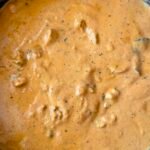



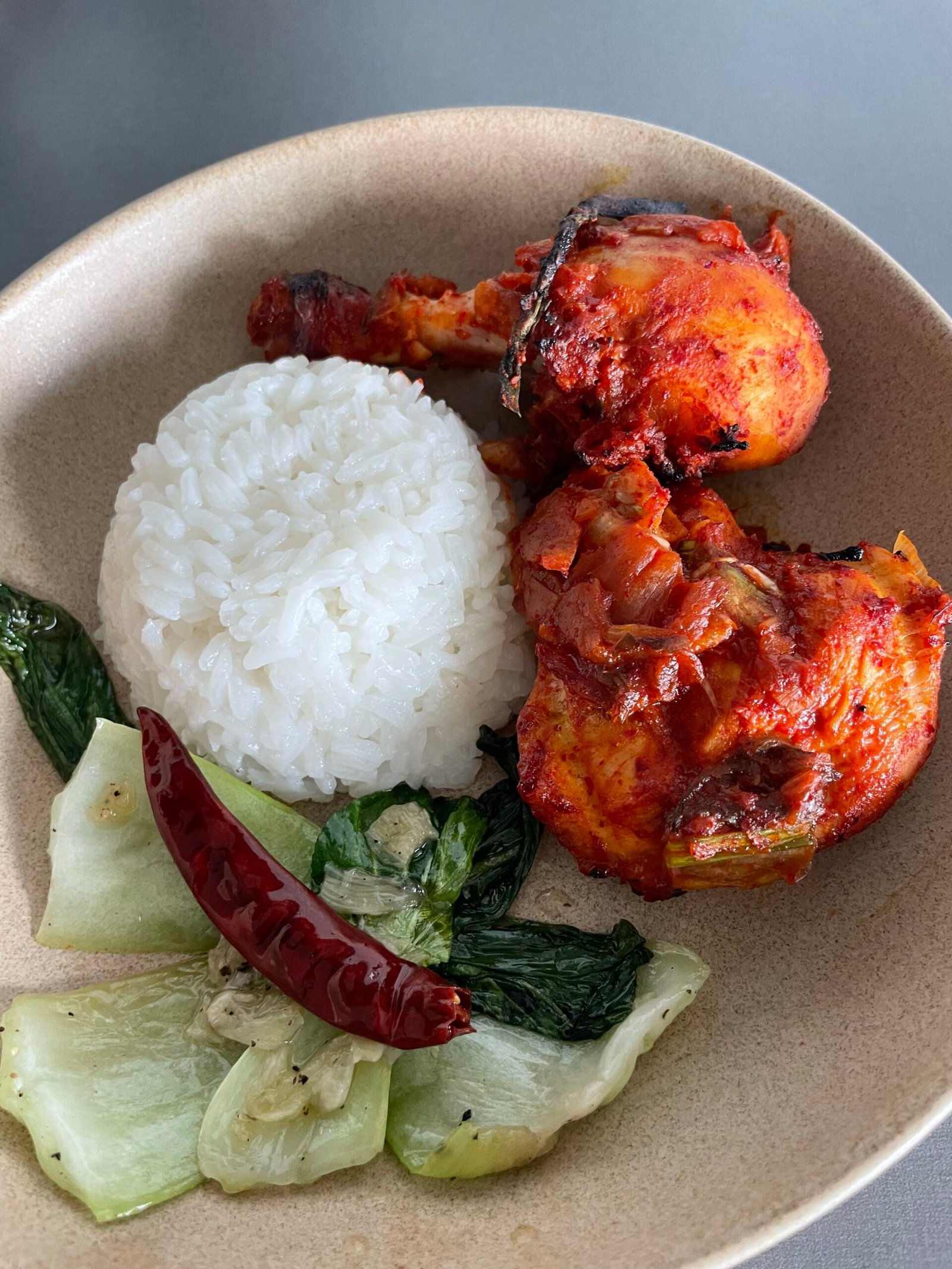
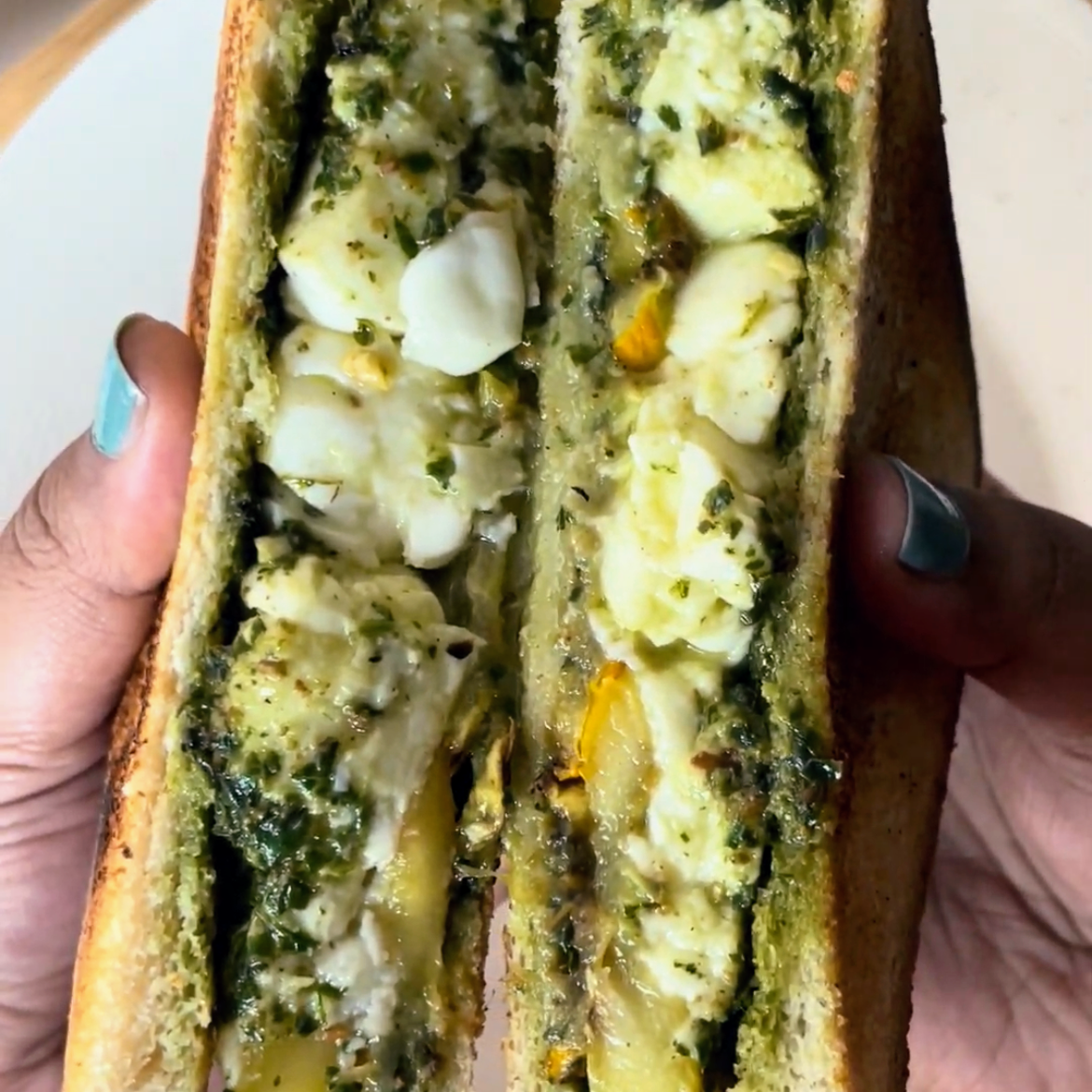
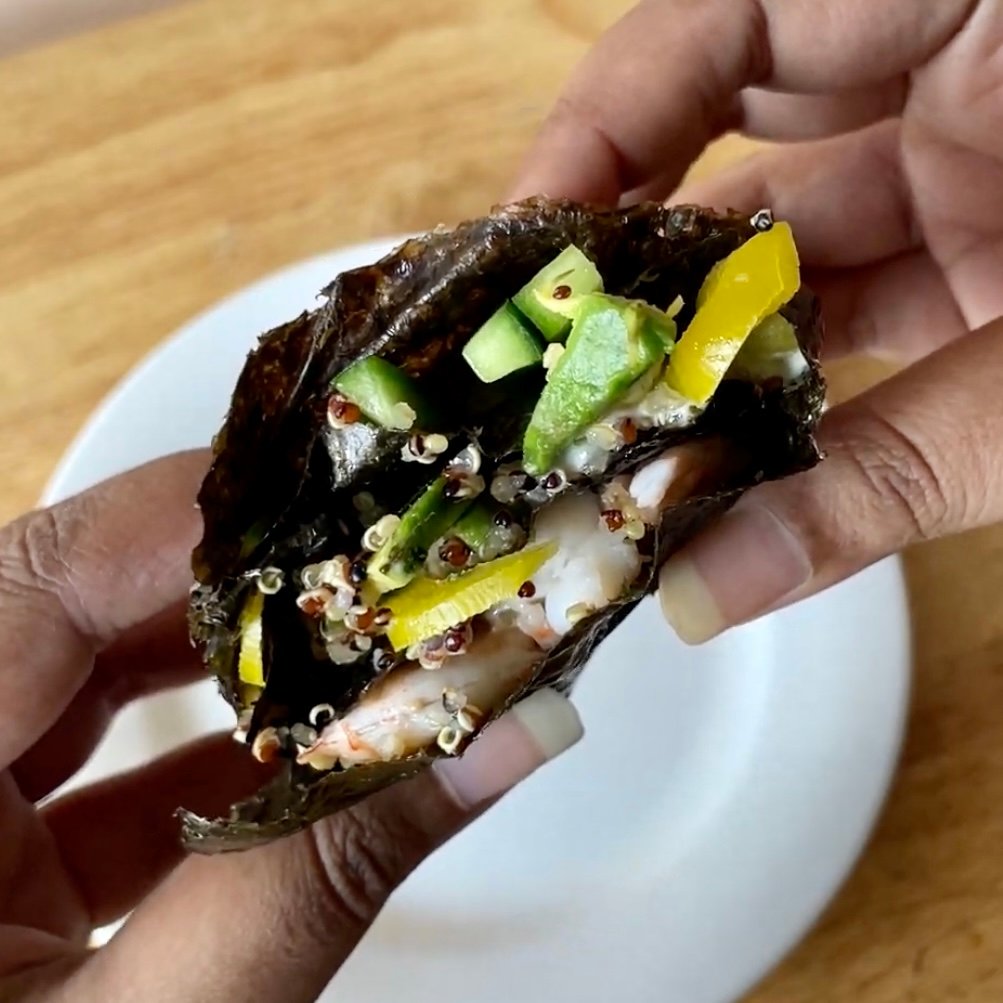
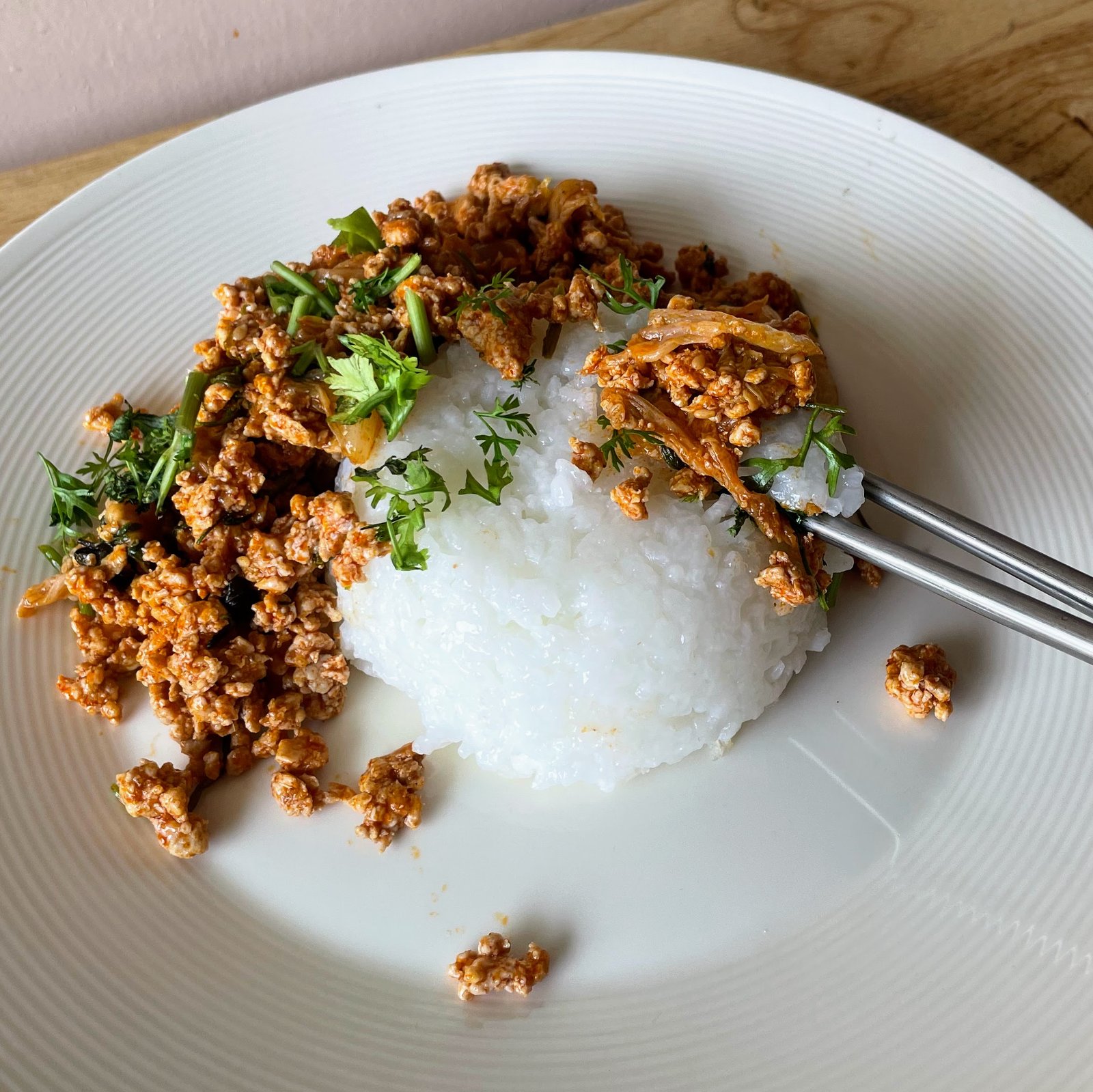
Leave a Reply